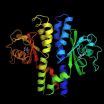(Press-News.org) An ancient heart drug that's inspired the work of herbalists and poets for centuries may treat a condition that plagues millions of overstressed and overweight Americans today.
Since the 13th century, the herb Foxglove has been used to cleanse wounds and its dried leaves were brewed by Native Americans to treat leg swelling caused by heart problems.
In an article published online today in Molecular Pharmacology, researchers at the University of Michigan Health System reveal that digoxin, the active ingredient in digitalis, or Foxglove, can enhance the body's own protective mechanism against high blood pressure and heart failure.
High blood pressure can be prevented by reducing salt intake, being active and keeping a healthy weight, but about 1 in 3 Americans has high blood pressure, also called hypertension, which can damage the body in many ways.
Most current treatments prevent excess hormone and stress signals that can lead to high blood pressure and heart failure.
But recent studies have found that the body has the ability to keep excess stimulation in check through production of a family of inhibitors called RGS proteins.
Researchers looked for ways to "re-purpose" old drugs to tap into this protective mechanism which is lost among some individuals with high blood pressure and heart failure.
"We tested several thousand known drugs and bioactive molecules for a potential role in enhancing RGS2 and/or RGS4 expression and function and have identified a novel mechanism for digoxin," says lead study author Benita Sjogren, Ph.D., a research fellow in the Department of Pharmacology at the University of Michigan.
Case histories collected by Dr. William Withering in 1775 determined that Foxglove contained the active ingredient, digoxin, now an important drug for treating patients with congestive heart failure.
This new action of digoxin was found by treating engineered human kidney cells with thousands of known drugs in a high-throughput screen at the U-M Center for Chemical Genomics. Digoxin was then shown to have similar actions in isolated mouse blood vessel cells.
"In addition to test tube studies, low dose digoxin, the active ingredient of digitalis, was able to increase RGS2 levels in the heart and kidney," says senior study author and pharmacologist Rick Neubig, M.D., Ph.D., professor of pharmacology, associate professor of internal medicine, and co-director of the Center for Chemical Genomics at the University of Michigan.
"This new action of digoxin could help explain the fact that low doses seem to improve the survival of heart failure patients. It also suggests new uses for low dose digoxin or other drugs that can activate this protective mechanism," he says.
Neubig's lab at the U-M focuses on the large family of RGS proteins and the role they play in the function of the brain, heart, immunity and cancer and how they can be exploited in therapeutics.
INFORMATION:
Additional authors: Sergio Parra, M.D., Lauren J. Heath, B.S., Kevin B. Atkins, all of the U-M, and Zie-Jian Xie, Ph.D., of the Department of Physiology and Pharmacology, College of Medicine, University of Toledo, Toledo, Ohio.
Reference: "Cardiotonic steroids stabilize RGS2 protein levels," Molecular Pharmacology, published online before print June 13, 2012, doi: 10.1124/mol.112.079293.
Resource:
U-M Department of Pharmacology
http://www.pharmacology.med.umich.edu/Pharmacology/Home.html
The Center for Chemical Genomics, housed in the Life Sciences Institute at U-M, assists researchers in carrying out high-throughput (HTS) screens of chemical and siRNA libraries to identify new tools for biological research.
http://lsi.umich.edu/ccg
New action for ancient heart drug
University of Michigan Health System study shows a drug used for centuries activates the body's own protective mechanisms in blood vessels
2012-06-15
ELSE PRESS RELEASES FROM THIS DATE:
Link between metabolic disorders and Alzheimer's disease examined
2012-06-15
Amsterdam, NL, June 14, 2012 – No effective treatments are currently available for the prevention or cure of Alzheimer's disease (AD), the most frequent form of dementia in the elderly. The most recognized risk factors, advancing age and having the apolipoprotein E Ɛ4 gene, cannot be modified or treated. Increasingly, scientists are looking toward other risk factors to identify preventive and therapeutic strategies. Much attention recently has focused on the metabolic syndrome (MetS), with a strong and growing body of research suggesting that metabolic disorders ...
Fragile X gene's prevalence suggests broader health risk
2012-06-15
MADISON – The first U.S. population prevalence study of mutations in the gene that causes fragile X syndrome, the most common inherited form of intellectual disability, suggests the mutation in the gene – and its associated health risks – may be more common than previously believed.
Writing this month (June 2012) in the American Journal of Medical Genetics, a team of Wisconsin researchers reports that the cascade of genetic amino acid repeats, which accumulate over generations and culminate in the mutation of a single gene causing fragile X, is occurring with more frequency ...
Scientists sequence genome of human relative that prefers love over war
2012-06-15
COLUMBUS, Ohio – An international team of scientists has sequenced the genome of the bonobo, a primate that, along with chimpanzees, is the closest living relative of humans. Unlike chimpanzees, which have an aggressive nature, bonobos tend to be peaceful, playful and highly sexual.
The study, published online in the journal Nature, compares the bonobo genome to the genomes of chimpanzees and humans.
As part of the study, scientists at the Ohio State University Comprehensive Cancer Center – Arthur G. James Cancer Hospital and Richard J. Solove Research Institute (OSUCCC ...
JILA frequency comb helps evaluate novel biomedical decontamination method
2012-06-15
Like many new measurement tools, the laser frequency comb seemed at first a curiosity but has found more practical uses than originally imagined. The technique for making extraordinarily precise measurements of frequency has now moved beyond physics and optics to advance biomedicine by helping researchers evaluate a novel instrument that kills harmful bacteria without the use of liquid chemicals or high temperatures.
Generated by ultrafast lasers, frequency combs precisely measure individual frequencies (colors) of light. Researchers at JILA, operated jointly by the ...
Single-track sustainability 'solutions' threaten people and planet
2012-06-15
The targets, indicators and approaches being used to pursue progress towards sustainable development at Rio+20 are counter-productive, say scientists in a new paper.
Goals focussing on one-track scientific solutions to the most urgent sustainability problems fail to respond to the uncertainty and shifting dynamics of today's world. These one-direction approaches risk breaching the already weakened planetary boundaries which define a safe operating space for humanity, while undoing past progress on global poverty reduction.
Instead, sustainable futures should be plotted ...
For future prosperity, US should strengthen efforts to maintain world-class research universities
2012-06-15
WASHINGTON — American research universities are essential for U.S. prosperity and security, but the institutions are in danger of serious decline unless the federal government, states, and industry take action to ensure adequate, stable funding in the next decade, says a new report by the National Research Council, the operating arm of the National Academy of Sciences and National Academy of Engineering. As trusted stewards of public funds, universities must also meet "bold goals" to contain costs, enhance productivity, and improve educational pathways to careers both ...
Green grabs: The dark side of the green economy
2012-06-15
'Green grabbing' - the rapidly-growing appropriation of land and resources in the name of 'green ' biofuels, carbon offsetting schemes, conservation efforts and eco-tourism initiatives – is forcing people from their homelands and increasing poverty, new research has found.
Ecosystems being 'asset-stripped' for profit is likely to cause dispossession and further poverty amongst already-poor land and resource users, according to a set of 17 new research case studies from Africa, Asia and Latin America, published in a special issue of the Journal of Peasant Studies.
"Green ...
Quirky fruit fly gene could point way to new cancer drugs
2012-06-15
MAYWOOD, Il. -- Loyola University Chicago researchers are taking advantage of a quirk in the evolution of fruit fly genes to help develop new weapons against cancer.
A newly discovered fruit fly gene is a simplified counterpart of two complex human genes that play important roles in the development of cancer and some birth defects. As this fruit fly gene evolved, it split in two. This split has made it easier to study, and the resulting insights could prove useful in developing new cancer drugs.
"Evolution has given us a gift," said Andrew K. Dingwall, PhD, senior author ...
Lessons learned from the 'ethical odyssey' of an HIV trial
2012-06-15
In the battle against HIV/AIDS conditions on the frontlines are constantly in flux as treatment, research and policy evolve. The landmark HIV Prevention Trials Network (HPTN) 052 study, which established that antiretroviral treatment in people who are HIV positive decreases the likelihood of transmitting HIV to their sexual partners, was no exception. One year after publication the study serves as a case study of ethical challenges faced at every stage of the research trial process in the new paper "Establishing HIV treatment as prevention in the HIV Prevention Trials ...
Atomic-resolution view of a receptor reveals how stomach bacterium avoids acid
2012-06-15
EUGENE, Ore. -- (June 14, 2012) -- University of Oregon scientists have discovered how the bacterium Helicobacter pylori navigates through the acidic stomach, opening up new possibilities to inactivate its disease-causing ability without using current strategies that often fail or are discontinued because of side effects.
Their report -- online ahead of regular publication July 3 in the journal Structure -- unveils the crystal structure of H. pylori's acid receptor TlpB. The receptor has an external protrusion, identified as a PAS domain, bound by a small molecule called ...
LAST 30 PRESS RELEASES:
Experiments advance potential of protein that makes hydrogen sulfide as a therapeutic target for Alzheimer’s disease
Examining private equity’s role in fertility care
Current Molecular Pharmacology achieves a landmark: real-time CiteScore advances to 7.2
Skeletal muscle epigenetic clocks developed using postmortem tissue from an Asian population
Estimating unemployment rates with social media data
Climate policies can backfire by eroding “green” values, study finds
Too much screen time too soon? A*STAR study links infant screen exposure to brain changes and teen anxiety
Global psychiatry mourns Professor Dan Stein, visionary who transformed mental health science across Africa and beyond
KIST develops eco-friendly palladium recovery technology to safeguard resource security
Statins significantly reduce mortality risk for adults with diabetes, regardless of cardiovascular risk
Brain immune cells may drive more damage in females than males with Alzheimer’s
Evidence-based recommendations empower clinicians to manage epilepsy in pregnancy
Fungus turns bark beetles’ defenses against them
There are new antivirals being tested for herpesviruses. Scientists now know how they work
CDI scientist, colleagues author review of global burden of fungus Candida auris
How does stroke influence speech comprehension?
B cells transiently unlock their plasticity, risking lymphoma development
Advanced AI dodel predicts spoken language outcomes in deaf children after cochlear implants
Multimodal imaging-based cerebral blood flow prediction model development in simulated microgravity
Accelerated streaming subgraph matching framework is faster, more robust, and scalable
Gestational diabetes rose every year in the US since 2016
OHSU researchers find breast cancer drug boosts leukemia treatment
Fear and medical misinformation regarding risk of progression or recurrence among patients with breast cancer
Glucagonlike peptide-1 receptor agonists and asthma risk in adolescents with obesity
Reviving dormant immunity: Millimeter waves reprogram the immunosuppressive microenvironment to potentiate immunotherapy without obvious side effects
Safety decision-making for autonomous vehicles integrating passenger physiological states by fNIRS
Fires could emit more air pollution than previously estimated
A new way to map how cells choose their fate
Numbers in our sights affect how we perceive space
SIMJ announces global collaborative book project in commemoration of its 75th anniversary
[Press-News.org] New action for ancient heart drugUniversity of Michigan Health System study shows a drug used for centuries activates the body's own protective mechanisms in blood vessels


